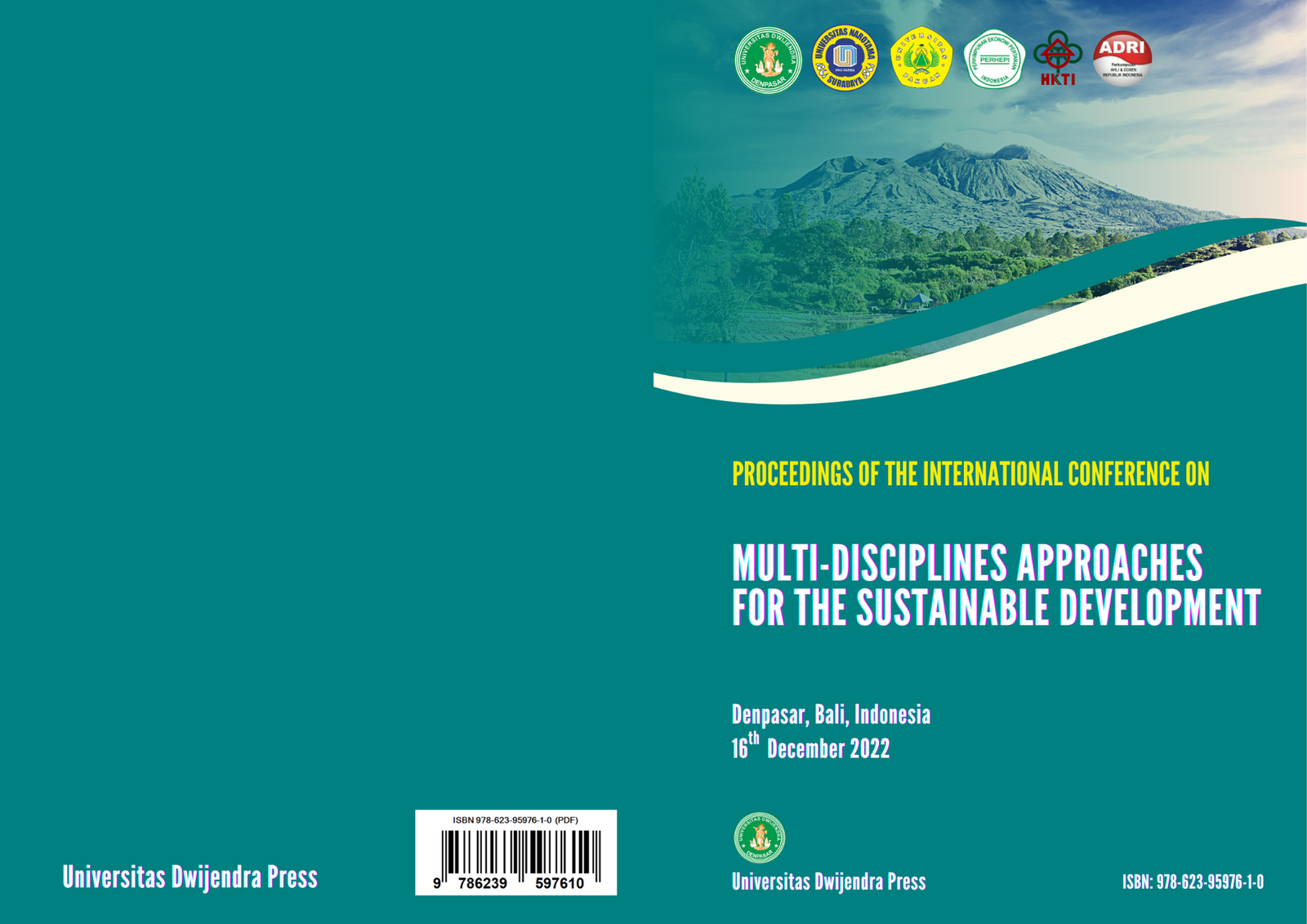CARRYING CAPACITY ANALYSIS OF PADDY FIELD-BASED FOOD AND ENVIRONMENT IN PURWAKARTA REGENCY, WEST JAVAJUDUL
Abstract
Food is a basic human need. The provision of food is realized to meet the needs and consumption of food for the community, both individually and households in a sustainable manner. One of the efforts to realize domestic food availability is to maintain and develop productive lands. The purpose of this study was to analyze the rate of conversion of paddy fields on a spatial basis in the 2013-2017 period and the 2017-2021 period in Purwakarta Regency, project land availability and demand for paddy fields in 2045, and analyze the environmental carrying capacity of the district. The research was conducted in January-April 2022, in Purwakarta Regency, West Java, using a quantitative descriptive method using secondary data analyzed with ArcGIS 10.8, Powersim 10, and Google Earth Pro. The results showed that in the 2013-2017 period, paddy fields were reduced into built-up areas of 195.55 ha, and in the 2017-2021 period there was a reduction of paddy fields into built-up areas of 401.83 ha. Based on the spatial planning for the 2011-2031 Purwakarta Regency area, it is planned that there will be a change of rice fields into a built-up area of 3,742.94 ha. Purwakarta Regency will achieve food self-sufficiency if it has at least 14,439.65 ha of paddy fields, or the equivalent of producing 109,427.20 tonnes of rice. In the period 2031-2045 Purwakarta Regency will experience a food deficit and it tends to continue increasing until it reaches 43,527 tons of rice in 2045. The carrying capacity of the environment through the ecosystem services approach in Purwakarta Regency, namely in the form of providing food services in 2021 will reach 142,506.51 tons with food service recipients of 997,869 people. Recipients of food services will continue to increase to 1,095,934 people in 2045. There is a need for policy intervention through policy scenarios for optimizing paddy fields and increasing productivity, or a combination of both, to increase the carrying capacity of food in Purwakarta Regency.
References
Badan Pusat Statistik [BPS]. 2018. Proyeksi Penduduk Indonesia 2015 – 2045. Hasil SUPAS 2015 (Edisi Revisi). Jakarta: BPS RI.
Badan Pusat Statistik Kabupaten Purwakarta [BPS Kab. Purwakarta]. (2021). Statistik Daerah Kabupaten Purwakarta 2021. Badan Pusat Statistik Kabupaten Purwakarta. Purwakarta (ID): BPS Kabupaten Purwakarta.
Clapp, J. (2015). The State of Agricultural Commodity Markets In Depth: Food and Agriculture Organization of the United Nations.
Clapp, J. (2017). Food self-sufficiency: Making sense of it, and when it makes sense. Food Policy, 66: 88-96.
Firmansyah. (2016). Model Pengendalian Konversi Lahan Sawah di Dalam DAS Citarum. (Tesis). Bogor: Sekolah Pascasarjana, Institut Pertanian Bogor.
Hardjoamidjojo, S. (1997). Peranan irigasi dan permasalahannya dalam swasembada beras di Indonesia. Buletin Keteknikan Pertanian, 11(1): 44-53.
Ichwal, Z., Romano., & Agus, N. (2019). Conversion of paddy fields and impact on farmers’ income in Aceh Besar District of Indonesia: A case study of Darul Imarah Subdistrict. Russian Journal of Agricultural and Socio-Economic Science (RJOAS), 11(95): 257-262. DOI 10.18551/rjoas.2019-11.36
Irwansyah, E. (2013). Sistem Informasi Geografis: Prinsip Dasar dan Pengembangan Aplikasi. Yogyakarta: Digibooks Printing and Publishing.
Millennium Ecosystem Assessment (2005). Ecosystems and Human Well-being: Synthesis. Island Press, Washington, DC.
Pambudi, A.S. (2021). Overview and evaluation of the Indonesia’s water resources management policies for food security. Indonesian Journal of Applied Environmental Studies, 2(2): 84-93. DOI: 10.33751/injast.v2i2.3586
Peraturan Presiden Republik Indonesia Nomor 18 Tahun 2020 tentang Rencana Pembangunan Jangka Menengah Nasional Tahun 2020-2024
Peraturan Presiden Republik Indonesia Nomor 59 Tahun 2019 tentang Pengendalian Alih Fungsi Lahan Sawah
Permadi, K. & Sunandar, B. (2013). Penerapan berbagai inovasi teknologi yang mendukung Program Peningkatan Produksi Beras Nasional (P2BN) di Kabupaten Purwakarta (review). AGROTRO, 3(1):1-9.
Ramadhan, R., Widiatmaka, & Sudadi, U. (2016). Perubahan penggunaan lahan dan pemanfaatan ruang pada wilayah rawan longsor di Kabupaten Banjarnegara, Jawa Tengah. Jurnal Pengelolaan Sumberdaya Alam dan Lingkungan, 6(2): 159-167.
Ruswandi, A., Rustiadi, E., & Mudikdjo, K. (2007a). Konversi lahan pertanian dan dinamika perubahan penggunaan lahan di kawasan Bandung Utara. Jurnal Tanah dan Lingkungan, 9(2): 63-70.
Ruswandi, A., Rustiadi, E., & Mudikdjo, K. (2007b). Dampak konversi lahan pertanian terhadap kesejahteraan petani dan perkembangan wilayah: Studi kasus di daerah Bandung Utara. Jurnal Agro Ekonomi, 25(2): 207-219.
Setyorini, D., Rochayati, S., & Las, I. (2010). Membalik Kecenderungan Degradasi Sumber Daya Lahan dan Air: Pertanian pada Ekosistem Lahan Sawah. [Editor: Suradisastra K, et.al]. Badan Penelitian dan Pengembangan Pertanian, Kementerian Pertanian. Bogor: IPB Press.
Sukiptiyah. (2022). Analisis Dampak Pola Peruntukan Ruang dalam Penempatan Lokasi Kegiatan Ekonomi Melalui Mekanisme Konversi Lahan Sawah di Perdesaan (Studi Kasus: Provinsi Jawa Barat). (Tesis). Ilmu Perencanaan Pembangunan Wilayah dan Perdesaan, Fakultas Ekonomi dan Manajemen, Bogor: Sekolah Pascasarjana Institut Pertanian Bogor.
Undang-Undang Dasar Negara RI Tahun 1945
Undang-Undang Republik Indonesia Nomor 18 Tahun 2012 tentang Pangan.
Undang-Undang Republik Indonesia Nomor 32 Tahun 2009 tentang Perlindungan dan Pengelolaan Lingkungan Hidup
Undang-Undang Republik Indonesia Nomor 41 Tahun 2009 tentang Perlindungan Lahan Pertanian Pangan Berkelanjutan.
Waage, J. (2022). Understanding the relationship between environment, agriculture and health: An interdisciplinary challenge. Indonesian Journal of Applied Environmental Studies, 3(1): 1-4. DOI: 10.33751/injast.v3i1.5075
Wahyunto & Widiastuti, F. (2014). Lahan sawah sebagai pendukung ketahanan pangan serta strategi pencapaian kemandirian pangan. Jurnal Sumberdaya Lahan, Edisi Khusus: 17-30.
Zhang, H., & Lang, Y. (2022). Quantifying and analyzing the responses of habitat quality to land use change in Guandong Province, China, over the past 40 years. Land, 11(817): 1-23. https://doi.org/10.3390/land11060817.




